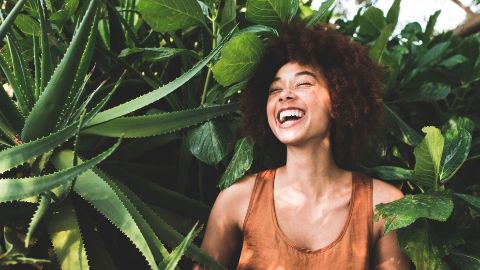
From Summit to Valley
How did edelweiss go from the top of the mountain to the valley? What makes this plant, with its velvety flowers, so valuable? In the canton of Valais in Switzerland, however, edelweiss is available in the valley as an organic crop.
Catherine Tornay woke up early on this summer day. The Valais native is waiting for just about her entire family to arrive at the fields above Orsières: her sisters and brother-in-law, her sisters-in-law as well as her nieces. Edelweiss is harvested only once a year here, and only when everyone helps can they finish before lunchtime. That’s why Catherine is out early on the field, giving instructions to the harvesters. She is not the only one in the family who looks after these plants from spring to late autumn, but today she is clearly the boss. Catherine’s husband Pascal arrives with the trailer. Later he will transport the edelweiss blossoms to the Valplantes farmers’ cooperative further down in the valley for drying. Until then, the 1,000-square-metre field is all about bending over, cutting, carrying and bending over again. Catherine and her family have been growing edelweiss for more than ten years, and are the only ones in the valley to do so.
For a hundred years, people have been picking edelweiss in the mountains and planted seeds in their garden.


History of the Cultivated Plant
Why cultivate edelweiss and other wild alpine plants? Weleda along with another Swiss company came up with the idea in the 1980s. Their proposal fell on fertile ground at Agroscope, a Swiss federal research institute. In the mid-1990s, Charly Rey, an Agroscope researcher, began to breed alpine plants; his successor is now José Vouillamoz. The Phyto-Chemist has made himself comfortable on a bench overlooking Orsières and the edelweiss field. He has been here often and knows the valley, whose southern end is marked by the Great St. Bernard Pass. Vouillamoz has come from the Rhône Valley on this harvest day to tell the story of edelweiss as a cultivated plant.
Where Edelweiss grows
Some bloomed in June, others only weeks later
“For a hundred years, people have been picking edelweiss in the mountains and successfully planted seeds in their own garden, it’s not hard at all. There were also first instances of cultivated edelweiss available for purchase in the shops. What interested us was how to cultivate edelweiss plants in large quantities, professionally,” he says. His predecessor soon found out: “No, their development was too heterogeneous – some of them would shoot upwards, while others remained very small; some bloomed in June, others only weeks later.” Studies of the plants at the time revealed that their composition was also quite varied. These were all poor conditions for cultivating plants that, due to their later use, are expected to be more or less the same size, contain the same amounts of active ingredients and mature at the same time.
The work is intensive and time-consuming, all the more so as we cultivate all our medicinal and spice plants organically
Rey’s idea was to breed an edelweiss plant that would meet all these requirements. He took wild and already cultivated specimens and crossed them. Of the twenty hybrids that were produced in this way for the research team, one was just about perfect, with tall stems and the beautiful flowers of uniform size: the “Helvetia” edelweiss was born. In 2006, the pioneers planted their first field in the same location as today’s harvest. Those first plants cultivated for further processing were included as an extract in Weleda’s sun care products at the time. And some of the edelweiss that Catherine Tornay and her family are now harvesting is entering the new generation of Weleda sun care products as an important ingredient.
What makes edelweiss so valuable as a cultivated plant? José Vouillamoz knows the answer and the story behind it. He explains how colleagues from the University of Innsbruck in Austria discovered as part of a collaboration a molecule they called Leontopodic acid after the Latin name for edelweiss, Leontopodium alpinum. This molecule protects the plant’s DNA from the sun’s strong UVA and UVB rays, and serves as vital protection in the high elevations at which the plant grows. The high antioxidant capacity of edelweiss extract means it can help to protect the human skin from the negative effects of solar radiation.
Organic and Ethical Sourcing
Standing at the edge of the field, you can see bent backs – one, two, three, four, five… and more. Catherine’s husband Pascal shows the French intern who has joined them for a few weeks how to cut edelweiss: grasp a bunch of the plant and cut it off at a hand’s length below the blossoms with the hand sickle. Then it’s straight on to the next bunch. As the last clouds in the sky disappear, the sun shines hot onto the backs of the harvesters and the field grows emptier by the minute. As expected, by noon the harvest is complete and the trailer full. The farmers will be paid for the land they cultivate and their labour, not for the yield.
“That’s fairer,” says François Paul, who is responsible for the edelweiss cultivation site. “If there were a harvest shortfall, they would otherwise be left empty-handed. We don’t want that. The work is intensive and time-consuming, all the more so as we cultivate all our medicinal and spice plants organically.” This effort is reflected in the farmers’ pay, and for Catherine Tornay this means security. In agriculture, crop failures due to pests, weather or climate conditions can quickly cause farmers to lose income; here it’s different. Organic cultivation also means a lot of work, as most of it is done by hand. Once the seedlings have been planted in the field with the help of a tractor, it’s time to loosen and weed the soil. This is an especially time-consuming task, notes Catherine, who works full-time as a mail carrier for Swiss Post. “At peak times, we are out weeding the field every day by hand.” For the 53-year-old mother of four grown-up sons, “It’s a tiring but beautiful job. Edelweiss is an ideal complement to our other work.”
The fragrance reminds me of honey
Most of the edelweiss harvest is processed into an extract for cosmetic products
Catherine’s husband works for the canton as an agricultural advisor and also supports his brother, who also lives in the village of Reppaz above Orsières, in the livestock industry. At the sight of the full trailer the two of them joke about how much easier it is for them to pick edelweiss: “We used to risk our lives to impress the women. We had to climb up to over 2,500 metres until we found a single edelweiss. Now we just need to bend over a little. The only thing is that cultivating edelweiss gives us a sore back.” The brothers laugh. Most of the edelweiss harvest is processed into an extract for cosmetic products, and a small portion is used for tea. What does edelweiss smell like? For Catherine Tornay, it’s “Very subtle. It’s hard to describe – the fragrance reminds me of honey. I can smell it when there are many flowers lying together, like now in the trailer.”
After the harvest, the helpers drive to Catherine and Pascal’s home. On the terrace, which offers a beautiful view across the valley, the tables are already set and the food is waiting for the large, hungry family. The difficult weather conditions this year is one of the topics discussed at the table. For the edelweiss growers, however, this wasn’t a problem, because the originally high alpine plant is accustomed to surviving unpredictable and icy temperatures.














